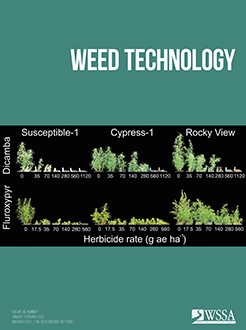Control of glyphosate-resistant (GR) junglerice is a challenging task in eastern Australia. There is limited information on the efficacy and reliability of alternate herbicides for GR populations of junglerice, especially when targeting large plants and when temperatures are high. A series of experiments were conducted to confirm the level of glyphosate resistance in three populations of junglerice and to evaluate the efficacy of alternate herbicides for the control of GR junglerice populations. The LD50 of glyphosate of B17/7, B17/34, and B17/35 populations was found to be 298, 2,260, and 1,715 g ae ha–1, respectively, suggesting that populations B17/34 and B17/35 were highly resistant to glyphosate. Glyphosate efficacy was reduced at high-temperature (35 C day/25 C night) compared with low-temperature conditions (25 C day/15 C night), suggesting that control of susceptible populations may also be reduced if glyphosate is sprayed under hot conditions. Preemergence herbicides dimethenamid-P (1,000 g ai ha–1) and pendimethalin (1,500 g ai ha–1) provided 100% control of GR populations (B17/34 and 17/35). Postemergence herbicides, such as clethodim (60 or 90 g ai ha–1), glufosinate (750 g ai ha–1), haloxyfop (52 or 78 g ai ha–1), and paraquat (400 or 600 g ai ha–1), applied at the four-leaf stage provided 100% control of GR populations. For larger junglerice plants (eight-leaf stage), postemergence applications of paraquat (400 or 600 g ai ha–1) provided greater weed control than clethodim, glufosinate, and haloxyfop. A mixture of either glufosinate or haloxyfop with glyphosate provided poor control of GR junglerice populations compared with application of glufosinate or haloxyfop applied alone. Efficacy of glufosinate and haloxyfop for the control of GR populations decreased when applied in the sequential spray after glyphosate application. This study identified alternative herbicide options for GR junglerice populations that can be used in herbicide rotation programs for sustainable weed management.
Nomenclature: Clethodim; dimethenamid-P; glufosinate; glyphosate; haloxyfop; paraquat; pendimethalin; junglerice; Echinochloa colona (L.) Link






